#Aquilegia atrata
Photo

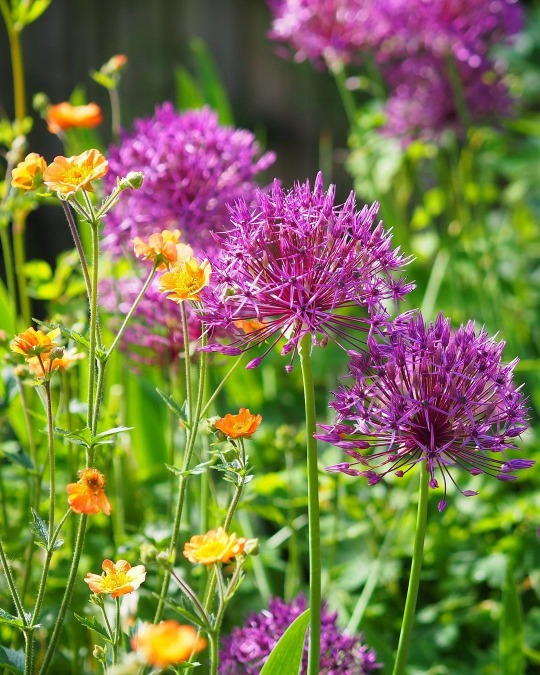
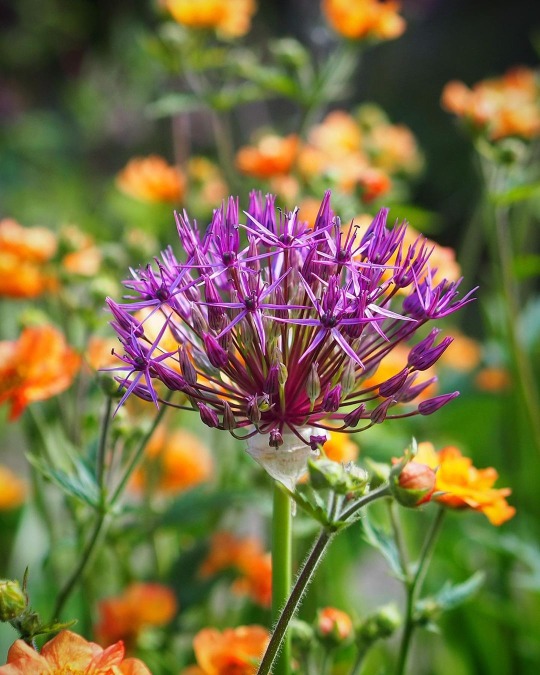

A muddle of Allium ‘Purple Rain’, Geum ‘Totally Tangerine’ and Aquilegia atrata welcomed me as I bound out the back door home from the Chelsea Flower Show this evening. 💜🧡
~ Ann-Marie Powell
296 notes
·
View notes
Text



A - Aquilegia atrata W.D.J.Koch - Aquilegia scura (Ranunculaceae)
12 notes
·
View notes
Text
Currently working as a waiter and cleaner at a mountain hut in Friuli. It's tough but very nice. I'm glad to be working. There's no internet connection, so we use the satellite and the radio bridge for phone calls (that's been the same in use since the '70 wow).
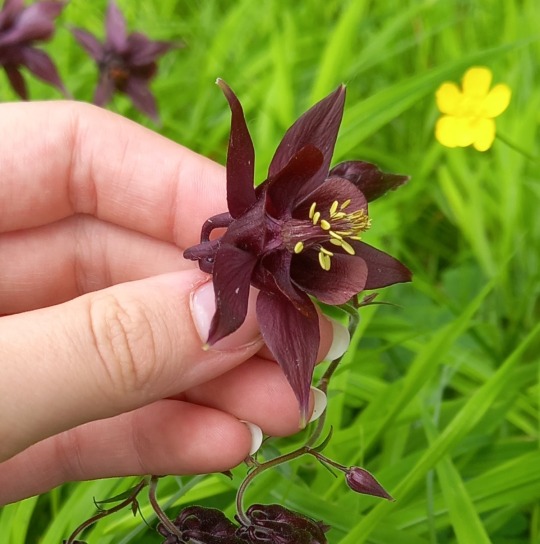
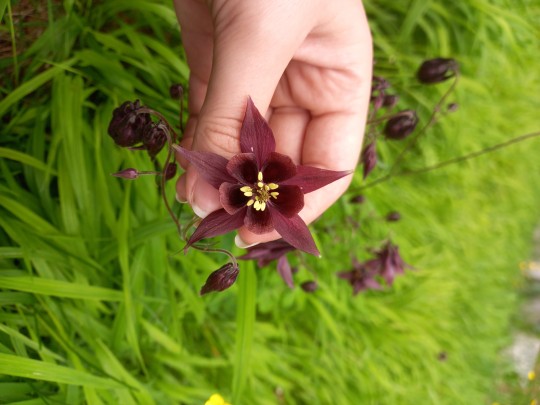
Here's a cool flower that grows there: Aquilegia atrata
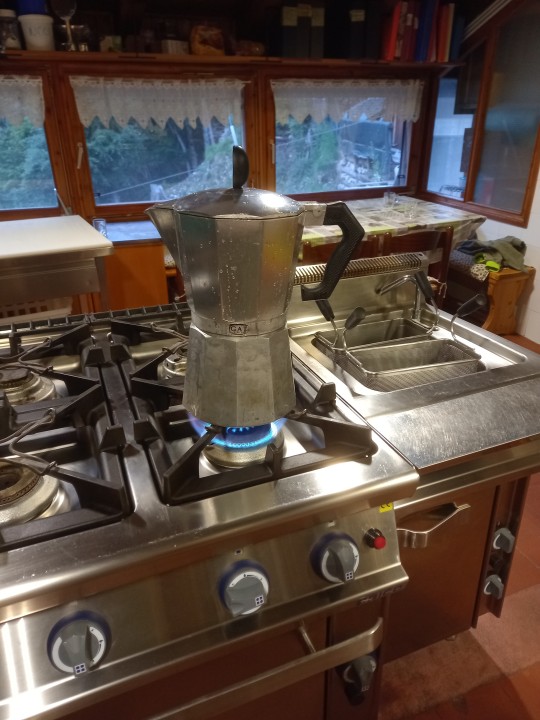
And here's the 3 liter moka we use for the coffe.
5 notes
·
View notes
Text
Wilde akelei en donkere akelei. Ranonkelfamilie
Wilde akelei en donkere akelei. Ranonkelfamilie
Wilde akelei, Aquilegia vulgaris
De wilde akelei, Aquilegia vulgaris en de donkere akelei, Aquilegia atrata zijn typische bosrandbewoners. Op open plekken in het bos, langs paden, onder houtwallen zijn ze te vinden. Ook wel in de volle zon maar dan toch met een klein beetje schaduw ergens. In onze omgeving behoorlijk zeldzaam in het wild en vooral de donkere akelei zul je toch wat vaker in…

View On WordPress
0 notes
Photo


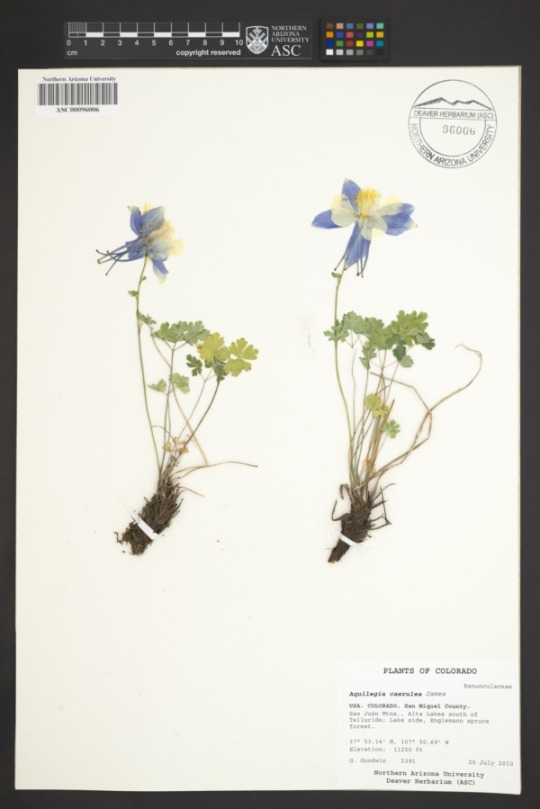


Flora of Horizon Zero Dawn - freeze rime root part 1: sketching the real and the unreal
Hello lovely people, we’re on to plant no. 2 in my Horizon Zero Dawn (HZD) video game botany collaboration with Dr Maria Christodoulou… Freeze rime root, which we’ll describe from the perspective of a Carja archivist.
For anyone who missed it, our first HZD plant was medicinal valley’s blush and you can see all the artwork and find links to our research on it here.
OK. Onwards to freeze-rime...
Freeze rime root & Colorado blue columbine
This plant is one of HZD’s most recognisable as closely resembling a present-day species. The game is set in Colorado, and freeze rime root is a dead ringer for Aquilegia caerulea, aka Colorado blue columbine or rocky mountain columbine.

Blue columbine by Rob Duval - Own work, CC BY-SA 3.0, https://commons.wikimedia.org/w/index.php?curid=29940845
Our fictional plant is common in all habitats and is used to craft freeze resist potions. Which means Maria and I can mess about making up fun/fiendish plant properties here - because it doesn’t need to be safe to eat! Potions could be used in multiple ways e.g. applied externally to skin or painted onto armor (not that Maria holds back on the edible plants… She did make medicinal valley’s blush laxative in high quantities after all.)
With my pharmacologist hat on, real columbines contain a variety of interesting compounds such as lactones, saponins, flavinoids, and various fatty acid-derivatives. Some of these have medicinal properties that could be relevant for our imaginary plant, e.g. effects on skin. Others have effects on insects that we could extrapolate to being useful for freeze rime root survival. So there’s some ready-made biochemistry we can play with.
With my artist hat on, these plants also have very distinctive flower and leaf shapes that I’m curious to try drawing in the style of a Carja archivist - especially given the stylised motifs we see in Carja architecture and fabrics in the city of Meridian. All of the win then? We shall see...

Aquilegia caerulea specimen from Colorado College Carter Herbarium (COCO), catalogue number COCO-V-0010526 via SEINet
Where do I start?
My first job art-wise is to work out how Aquilegia caerulea is built. I live in the UK so it’s no surprise that I haven’t seen A. caerulea in the wild. Thankfully the internet exists, and online herbarium resources from around the world are available. The specimen image above is one of many I can access.
We also have wild columbine species in the UK I can look at, and some grow among the many ‘weeds’ I cultivate in my back yard - common columbine or granny’s bonnet, A. vulgaris, and probably dark columbine, A. atrata, to be specific. I say ‘probably’ there because they’re not readily distinguishable from each other, but what matters is that they give me a better idea of leaf/flower/seed head structure for this genus of plants.

Leaves of a wild columbine growing in my back yard
WTF, buttercup??
That’s basically the first comment in my notes about this plant. When Maria told me columbines are in the buttercup family (Ranunculaceae), I said ‘what the fuck – it’s a BUTTERCUP?!??’ Maria had to botany-splain leaf patterns to convince me, but actually you can see the resemblance when you look at buttercup vs. columbine leaf structure. (I’m still renaming columbines to ‘what-the-fuck buttercup’ in my notes though, heh.) Columbine leaves are subdivided into lobed leaflets.
The flowers have lots of fluffy stamens, 5 tube-like petals with a long spur ending in a nectar reservoir (accessible only to pollinators with long tongues), and 5 petal-like sepals. The seed heads have several sections containing small black seeds.

One of my first sketchbook pages on freeze rime root - I can’t believe it’s a buttercup. (Aquilegia vulgare is a common misspelling, btw. I’m common, what can I tell you.)
Leaf details
The particular what-the-fuck buttercup species we’re looking at have biternate/2-ternate leaves. In ternate leaves, the leaf stem divides into 3 so that the leaf is made of 3 leaflets. In a biternate leaf, each of those leaflets is further divided into 3. Below are some illustrations of that, and there’s also a nice look at Aquilegia biternate and triternate leaf shapes here
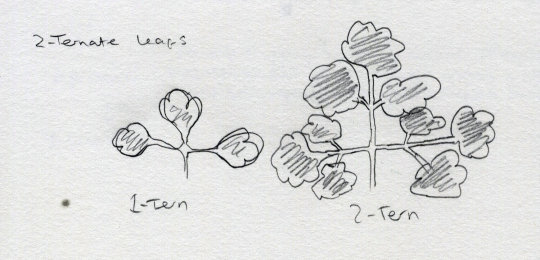
One of my notes on ternate leaves. Try not to think about my spelling.

Ternate pressed meadow buttercup leaves –diagram of a biternate leaf – a single biternate Aquilegia vulgaris leaf in my back yard. (Biternate compound leaf diagram by Wasp32 - Own work, CC BY-SA 4.0, https://commons.wikimedia.org/w/index.php?curid=49634190)
There are differences between leaves on my local columbine A. vulgaris and Colorado’s A. caerulea, visible even to a non-botanist like me. The leaflets are more deeply grooved, and (at least in the herbarium specimen images I’ve looked at) seem narrower and less rounded. I’ll leave it to Maria to torment/inform me more on the proper technical description for that though.

Aquilegia caerulea specimen showing leaf structure with deeply grooved leaflets, from the Rocky Mountain Herbarium (RM), catalogue number 905181 via SEINet
Flower details
The flower petal spurs on A. caerulea are long and straight, unlike the curly spurs on A. vulgaris. This is apparently a product/driver of the plant’s relationship with pollinators. A. vulgaris is pollinated by long-tongued bees, and A. caerulea has a HAWKMOTH POLLINATOR aaaaay you knew I’d get moths in here somewhere, right? I doubt Maria will let me sneak in another imaginary moth just yet, but just so you know; A. caerulea loves moths.

Another sketchbook page on how Colorado blue columbine and Freeze rime root compare to each other
Enough of the real plant, what about Freeze rime root?
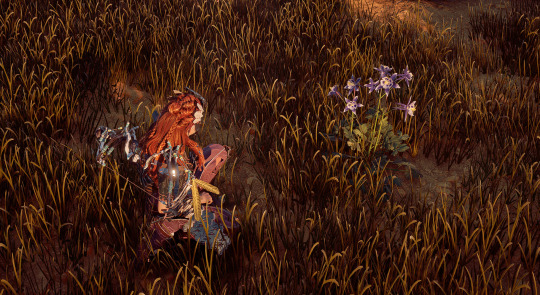
Aloy enjoying some quality botanising time
There are some noticeable differences between our fictional flowering plant and the present-day analogue, and you can see some below – the flowers are deeper purple, the petal spur tips are remarkably pointy, and the stamens look like cartoon hair that has just been electrocuted. The leaves are also quite rounded, more akin to my familiar local columbine.
How would we describe that and why might that be? Maria’s next post will fill you in on that, so stay tuned for a link which I’ll post here. She’ll be explaining how she looks at freeze rime root to write a formal scientific description, the next step before finding her inner Carja archivist voice.



Freeze rime root in the field
#hzd#horizon zero dawn#horizonzerodawn#video game botany#botany#botanical art#sciart#plants#columbine#aquilegia#flowers#VideoGameBotany#Aloy#Flora of HZD#Flora of Horizon Zero Dawn
8 notes
·
View notes
Text

100 wunderbare Wiesenkräuter, Wildblumen und Gräser die einzelne Trittsteine im Verbund mit anderen „Wilden Oasen“ als Überlebensbrücken zu bilden ermöglichen, können in Deinem Garten oder Blühstreifen, der für das Überleben von Tieren und Pflanzen in dieser Biodiversität, (Bio-Vielfalt) sorgt, auch mit viel Geduld wirksam entstehen.
Möglichst dann auch von Heckenschutz, Feuchtbiotopen und Baumbeständen begleitet in bester „Schutz- und Nutz-Gesellschaft“, die für Flora und Fauna in einem lebhaften Naturkreislauf sehr geeignet sind.
Unten in der Aufzählung ein paar Tipps, die ich im Internet von Manfred Vogt mit seinem OK zur Veröffentlichung für Euch „eingesammelt“ habe. ;)
-
—> Wer Sämereien davon sammelt und abgibt, bitte melden!
—> Wer Fläche für Wildwiesen zur Verfügung stellen möchte (auch die Gemeinde ist angesprochen!) und diese mit anderen Menschen aufbauen, schützen und erhalten möchte, bitte auch melden!
-
Hier nun die versprochenen 100 Wiesenkräuter, Wildblumen und Gräser:
Kreuzenzian
Helmknabenkraut
Teufelsabbiss
Kugelblume
Ästige Graslilie
Astlose Graslilie
Bergaster Aster amellus
Bergsandglöckchen
Orangerotes Habichtskraut
Wiesenflockenblume
Knöllchensteinbrech
Schwarze Teufelskralle - Phyteuma nigrum
Salomonsiegel
Acker-Stiefmütterchen - Viola arvensis
Fingerhut
Nickende Distel
Schwarze Königskerze - Verbascum nigrum
Rotes Waldvögelein - Cephalanthera rubra
Rotbraune Stendelwurz - Epipactis atrorubens
Schuppenwurz - Lathraea squamaria
Gewöhnliche Pechnelke - Lychnis viscaria
Gewöhnlicher Dolden-Milchstern - Ornithogalum umbellatum agg
Großer Ehrenpreis - Veronica teucrium
Kleiner Klappertopf - Rhinanthus minor
Zottiger Klappertopf - Rhinanthus alectorolophus
Wiesen-Salbei - Salvia pratensis
Rundblättriger Sonnentau - Drosera rotundifolia
Mittlerer Sonnentau - Drosera intermedia
Acker Wachtelweizen - Melampyrum arvense
Echtes Johanniskraut - Hypericum perforatum
Rote Lichtnelke - Silene dioica
Echtes Mädesüß - Filipendula ulmaria
Bach-Nelkenwurz - Geum rivale
Wiesen-Glockenblume - Campanula patula
Oregano - Origanum vulgare
Echter Arznei-Baldrian - Valeriana officinalis
Pracht-Nelke - Dianthus superbus
Wiesen Storchschnabel - Geranium pratense
Blutroter Storchschnabel - Geranium sanguineum
Österreichischer Lein - Linum austriacum
Schattenblümchen - Maianthemum bifolium
Zweiblättriger Blaustern - Scilla bifolia
Schwarzviolette Akelei - Aquilegia atrata
Kleiner Gelbstern - Gagea
minima
Wasserdost - Eupatorium cannabinum
Purpur-Fetthenne - Sedum telephium
Echtes Leinkraut (Linaria vulgaris)
Gewöhnlicher Natternkopf - Echium vulgare
Zweiblatt Ackerlauch - Allium ampeloprasum
Echte Schlüsselblume - Primula veris
Weinbergs-Lauch - Allium vineale
Hohe Schlüsselblume - Primula elatior
Bärlauch - Allium ursinum
Echtes Tausendgüldenkraut - Centaurium erythraea
Schmalblättriges Wollgras - Eriophorum angustifolium
Gewöhnliches Alpenglöckchen - Soldanella alpina
Schwanenblume - Butomus umbellatus
Schlankes Wollgras - Eriophorum gracile
Alpen-Aurikel - Primula auricula
Mehlprimel - Primula farinosa
Feuer-Lilie - Lilium bulbiferum
Wald-Engelwurz - Angelica sylvestris
Wundklee - Anthyllis vulneraria
Große Sterndolde - Astrantia major
Wiesensilge - Silaum silaus
Wald-Sanikel - Sanicula europaea
Bayerische Sterndolde - Astrantia bavarica
Dill - Anethum graveolens
Gewöhnliche Wiesen-Schafgarbe - Achillea millefolium
Fettwiesen-
Margerite - Chrysanthemum
ircutianum
Acker-Kratzdistel - Cirsium arvense
Kohl-Kratzdistel - Cirsium oleraceum
Großer Wiesenknopf - Sanguisorba officinalis
Wiesen-Bocksbart - Tragopogon pratensis
Wilde Karde - Dipsacus fullonum
Gewöhnliche Pestwurz - Petasites hybridus
Kleiner Wiesenknopf - Sanguisorba minor
Hasen-Klee - Trifolium arvense
Kornblume - Centaurea cyanus
Gemeine Wegwarte - Cichorium intybus
Gewöhnliche Kratzdistel - Cirsium vulgare
Wiesen-Witwenblume - Knautia arvensis
Tauben-Skabiose - Scabiosa columbaria
Huflattich - Tussilago farfara
Kugelköpfiger Lauch - Allium sphaerocephalon
Arnika - Arnica montana
Silberdistel - Carlina acaulis
Stengellose Kratzdistel - Cirsium acaule
Großblütige Gemswurz - Doronicum grandiflorum
Drüsenblättrige Kugeldistel - Echinops sphaerocephalus
Feld-Mannstreu - Eryngium campestre
Kugelige Teufelskralle - Phyteuma orbiculare
Jakobs-Greiskraut - Senecio jacobaea
Färberkamille - Anthemis tinctoria
Gold-Aster - Aster linosyris
Golddistel - Carlina vulgaris
Schlanke Karde - Dipsacus strigosus
Flachblättriger Mannstreu - Eryngium planum
Sand-Strohblume - Helichrysum arenarium
Rauhhaariger Alant - Inula hirta
Gewöhnliche Sumpf-Schafgarbe - Achillea ptarmica
-
—> Bin selbst an Sämereien oder Ablegern interessiert, oder als Samen der übrig ist für eine erste Tauschkisten Füllung.
—> Tauschkiste als solche habe ich erst einmal in Klein aus Holz schon.
—> Daher bitte einfach melden, wer beim Sämereien Sammeln/Tauschen mitmachen möchte; auch wenn wir nur gemeinsam erst einmal suchen, ernten, trocknen, sammeln, Saat auswerfen. Es ist ein guter Anfang.
Beispiele:
https://bluehende-landschaft.de/handlungsempfehlung/saatgut-vorschlaege/
https://wildwiesen.de/weiterfuehrende-informationen/
https://bluehstreifen-beelitz.de/tag/wildwiesen-anlegen/
©️®️CWG, 22.09.2021♈️🐏🌳
Bild: Rechte und Lizenzen frei über Pixabay.
2 notes
·
View notes
Photo
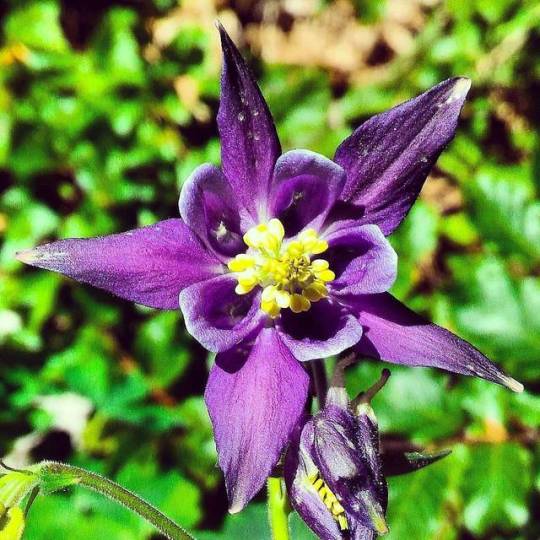
Aquilegia scura (Aquilegia atrata) . . . . . #aquilegia #aquilegiaatrata #flower #flowers #nature #italy #colors #love #instago #instamood #instagood #bestoftheday #picoftheday #photooftheday #tbt #follow #followme #hot #wildlife #life #wild #igersitalia #igers #pic #beautiful #art #follow4follow #igersfrosinone #viviciociaria
#wildlife#beautiful#igers#aquilegiaatrata#picoftheday#follow4follow#aquilegia#pic#wild#love#italy#instagood#nature#photooftheday#igersitalia#igersfrosinone#viviciociaria#flowers#instamood#flower#bestoftheday#followme#life#tbt#hot#art#instago#follow#colors
0 notes
Photo

aquilegia vulgaris atrata - high resolution image from old book.
0 notes
Photo

Album del Novecento. 50. Aquilegia scura (Aquilegia atrata W.D.J. Koch, Ranunculaceae)
17 notes
·
View notes
Photo
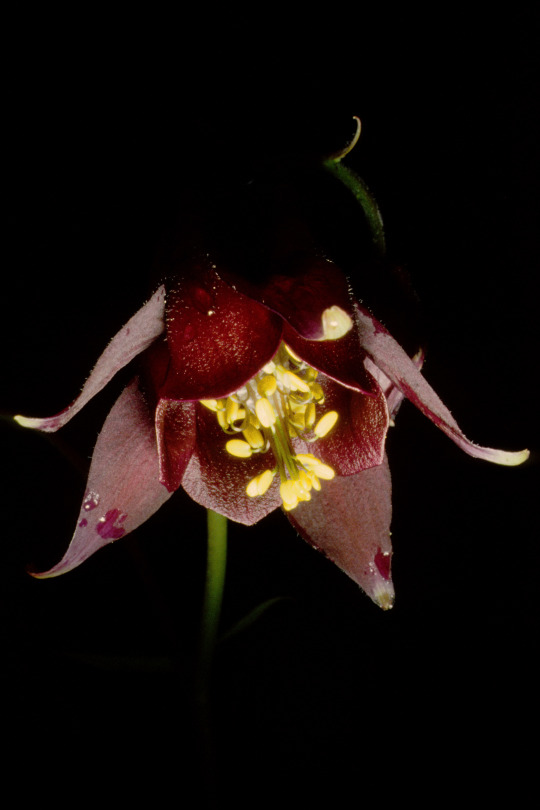
Album del Novecento. 74. Aquilegia scura (Aquilegia atrata W.D.J. Koch, Ranunculaceae)
9 notes
·
View notes